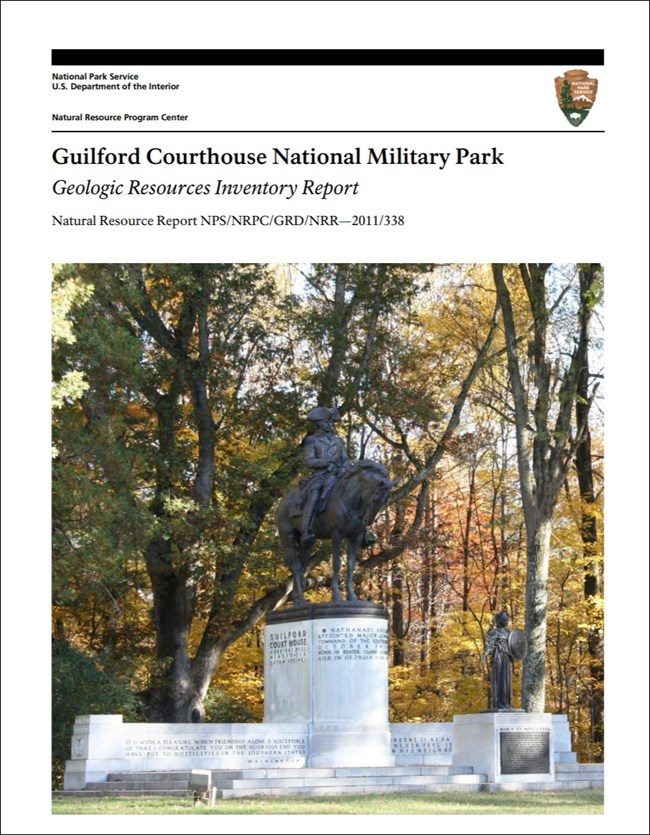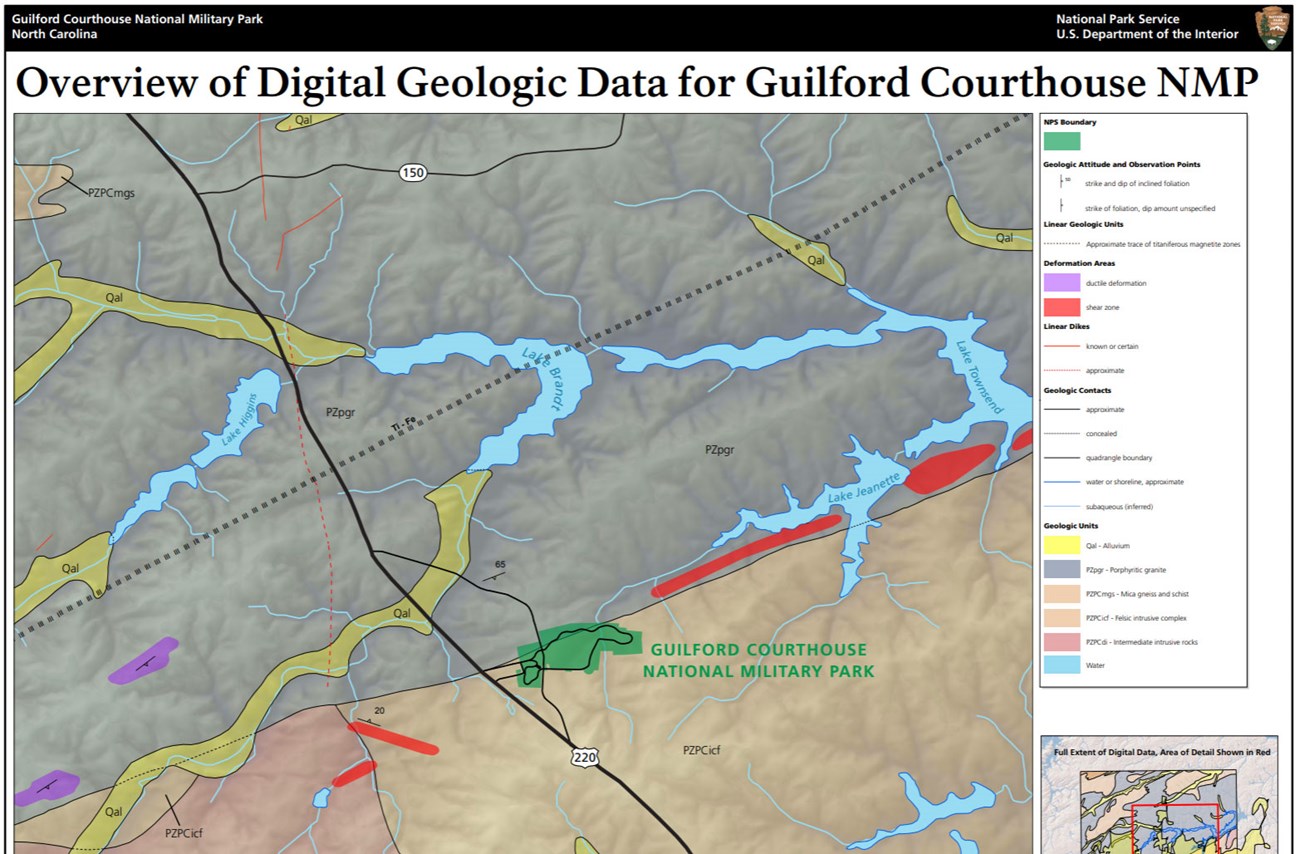Last updated: July 5, 2024
Article
NPS Geodiversity Atlas—Guilford Courthouse National Military Park, North Carolina
Geodiversity refers to the full variety of natural geologic (rocks, minerals, sediments, fossils, landforms, and physical processes) and soil resources and processes that occur in the park. A product of the Geologic Resources Inventory, the NPS Geodiversity Atlas delivers information in support of education, Geoconservation, and integrated management of living (biotic) and non-living (abiotic) components of the ecosystem.

Introduction
Guilford Courthouse National Military Park (GUCO) is located about 8 km (5 mi) northwest of downtown Greensboro adjacent to U.S. 220 (Battleground Avenue) in a picturesque area that stretches along the eastern foothills of the southern Appalachian Mountains in Guilford County, North Carolina. Established on March 2, 1917, GUCO contains approximately 101 hectares (251 acres) and preserves the battlefield and the accounts of the Battle of Guilford Courthouse during the Southern Campaign of the American Revolution (National Park Service 2014b, 2016a). In March of 1781 Major General Nathanael Greene and his army of almost 4,500 American militia were defeated by a smaller British army of about 1,900 veteran soldiers and German allies commanded by General Lord Charles Cornwallis. Although Greene and his army lost the Battle of Guilford Courthouse, the losses suffered by the British were so costly that Cornwallis ultimately changed his southern strategy and retreated to Virginia, allowing Greene to turn southward and retake control of the South. The Battle of Guilford Courthouse constitutes one in a series of events that led to ultimate American victory in the Revolutionary War (National Park Service 2014b).
Geologic Setting
Guilford Courthouse is located in the southern Appalachian Piedmont physiographic province, a region characterized by elongate, parallel belts of rock that were compressed, uplifted, and eroded as a result of numerous orogenies (mountain building episodes) that formed the Appalachian Mountains. Rocks of the Inner Piedmont are primarily layered metamorphic rocks such as schist, gneiss, amphibolite, or migmatite and contain numerous igneous intrusions in the form of layers, dikes, and small granite plutons. Geologic mapping in the vicinity of GUCO has revealed that the park is situated near an east–northeast trending shear zone between the Carolina Slate (east) and Charlotte (west) belts of metamorphosed rocks, all of which are part of the Carolina terrane (a crustal fragment that originated elsewhere and was transported to its current location) (Thornberry-Ehrlich 2011b). The oldest and most widely mapped unit in GUCO is a Precambrian–Paleozoic felsic intrusive complex with younger Paleozoic-age porphyritic granite underlying the northernmost portion of the park (Figure 30). Although relatively few surface exposures occur in GUCO, the relative resistance and structure of the underlying bedrock control the surficial landscape expression and determine the location of ridges, ravines, and other features.
Regional Geology
Guilford Courthouse National Military Park is a part of the Piedmont Physiographic Province and shares its geologic history and some characteristic geologic formations with a region that extends well beyond park boundaries.
- Scoping summaries are records of scoping meetings where NPS staff and local geologists determined the park’s geologic mapping plan and what content should be included in the report.
- Digital geologic maps include files for viewing in GIS software, a guide to using the data, and a document with ancillary map information. Newer products also include data viewable in Google Earth and online map services.
- Reports use the maps to discuss the park’s setting and significance, notable geologic features and processes, geologic resource management issues, and geologic history.
- Posters are a static view of the GIS data in PDF format. Newer posters include aerial imagery or shaded relief and other park information. They are also included with the reports.
- Projects list basic information about the program and all products available for a park.
Source: NPS DataStore Saved Search 2891. To search for additional information, visit the NPS DataStore.
A NPS Soil Resources Inventory project has been completed for Guilford Courthouse National Military Park and can be found on the NPS Data Store.
Source: NPS DataStore Saved Search 2962. To search for additional information, visit the NPS DataStore.
Related Articles
Guilford Courthouse National Military Park
National Park Service Geodiversity Atlas
The servicewide Geodiversity Atlas provides information on geoheritage and geodiversity resources and values within the National Park System. This information supports science-based geoconservation and interpretation in the NPS, as well as STEM education in schools, museums, and field camps. The NPS Geologic Resources Division and many parks work with National and International geoconservation communities to ensure that NPS abiotic resources are managed using the highest standards and best practices available.


